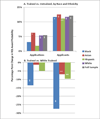Race, ethnicity, and NIH research awards
- PMID: 21852498
- PMCID: PMC3412416
- DOI: 10.1126/science.1196783
Race, ethnicity, and NIH research awards
Abstract
We investigated the association between a U.S. National Institutes of Health (NIH) R01 applicant's self-identified race or ethnicity and the probability of receiving an award by using data from the NIH IMPAC II grant database, the Thomson Reuters Web of Science, and other sources. Although proposals with strong priority scores were equally likely to be funded regardless of race, we find that Asians are 4 percentage points and black or African-American applicants are 13 percentage points less likely to receive NIH investigator-initiated research funding compared with whites. After controlling for the applicant's educational background, country of origin, training, previous research awards, publication record, and employer characteristics, we find that black applicants remain 10 percentage points less likely than whites to be awarded NIH research funding. Our results suggest some leverage points for policy intervention.
Figures



Comment in
-
Biomedical research funding. NIH uncovers racial disparity in grant awards.Science. 2011 Aug 19;333(6045):925-6. doi: 10.1126/science.333.6045.925. Science. 2011. PMID: 21852462 No abstract available.
-
Biomedical research funding. A minority viewpoint.Science. 2011 Aug 19;333(6045):926. doi: 10.1126/science.333.6045.926. Science. 2011. PMID: 21852463 No abstract available.
-
Sociology. Weaving a richer tapestry in biomedical science.Science. 2011 Aug 19;333(6045):940-1. doi: 10.1126/science.1211704. Science. 2011. PMID: 21852476 Free PMC article. No abstract available.
-
Race disparity in grants: check the citations.Science. 2011 Nov 18;334(6058):899; author reply 899-901. doi: 10.1126/science.334.6058.899-a. Science. 2011. PMID: 22096167 No abstract available.
-
Race disparity in grants: empirical solutions vital.Science. 2011 Nov 18;334(6058):899; author reply 899-901. doi: 10.1126/science.334.6058.899-b. Science. 2011. PMID: 22096168 No abstract available.
-
Race disparity in grants: oversight at home.Science. 2011 Nov 18;334(6058):901-3; author reply 903. doi: 10.1126/science.334.6058.901. Science. 2011. PMID: 22096170 No abstract available.
References
-
- National Science Foundation, Division of Science Resources Statistics. Women, Minorities, and Persons with Disabilities in Science and Engineering: 2009. (NSF 09-305, Arlington, VA 2009)
-
- Ginther DK, et al. Rochester, NY: Social Science Research Network; 2009. Available online at http://papers.ssrn.com/sol3/papers.cfm?abstract_id=1677993.
-
- Committee on Science, Engineering, and Public Policy. Expanding Underrepresented Minority Participation: America's Science and Technology Talent at the Crossroads. Washington, DC: National Academies Press; 2010.
Publication types
MeSH terms
Grants and funding
LinkOut - more resources
Full Text Sources

